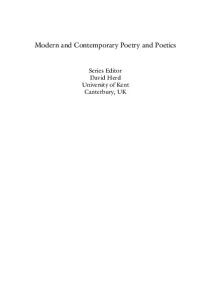Great Circles The Transits of Mathematics and Poetry
This volume explores the interaction of poetry and mathematics by looking at analogies that link them. The form that distinguishes poetry from prose has mathematical structure (lifting language above the flow of time), as do the thoughtful ways in which p
- PDF / 6,866,468 Bytes
- 275 Pages / 439.42 x 683.15 pts Page_size
- 20 Downloads / 329 Views
Emily Rolfe Grosholz
Great Circles The Transits of Mathematics and Poetry
Mathematics, Culture, and the Arts Series editors Jed Z. Buchwald Gizem Karaali Marjorie Senechal
The series Mathematics in Culture and the Arts publishes books on all aspects of the relationships between mathematics and the mathematical sciences and their roles in culture, art, architecture, literature, and music. This new book series will be a major resource for researchers, educators, scientifically minded artists, and students alike. More information about this series at http://www.springer.com/series/13129
Emily Rolfe Grosholz
Great Circles The Transits of Mathematics and Poetry
Emily Rolfe Grosholz Department of Philosophy The Pennsylvania State University University Park, PA, USA
ISSN 2520-8578 ISSN 2520-8586 (electronic) Mathematics, Culture, and the Arts ISBN 978-3-319-98230-4 ISBN 978-3-319-98231-1 (eBook) https://doi.org/10.1007/978-3-319-98231-1 Library of Congress Control Number: 2018954226 © Springer Nature Switzerland AG 2018 This work is subject to copyright. All rights are reserved by the Publisher, whether the whole or part of the material is concerned, specifically the rights of translation, reprinting, reuse of illustrations, recitation, broadcasting, reproduction on microfilms or in any other physical way, and transmission or information storage and retrieval, electronic adaptation, computer software, or by similar or dissimilar methodology now known or hereafter developed. The use of general descriptive names, registered names, trademarks, service marks, etc. in this publication does not imply, even in the absence of a specific statement, that such names are exempt from the relevant protective laws and regulations and therefore free for general use. The publisher, the authors, and the editors are safe to assume that the advice and information in this book are believed to be true and accurate at the date of publication. Neither the publisher nor the authors or the editors give a warranty, express or implied, with respect to the material contained herein or for any errors or omissions that may have been made. The publisher remains neutral with regard to jurisdictional claims in published maps and institutional affiliations. This Springer imprint is published by the registered company Springer Nature Switzerland AG The registered company address is: Gewerbestrasse 11, 6330 Cham, Switzerland
This book is dedicated to my friends Paula Deitz and Marjorie Lee Senechal, with admiration for their work as writers and editors.
Preface
Philosophy is inherently interdisciplinary, because it can reflect on the conditions of intelligibility or meaningfulness of almost anything. A philosopher is thus especially well suited to explore connections among disciplines and explain the import of those linkages. As a philosopher of mathematics, I have urged the use of historical case studies as a complement to logical investigations, in my co-edited volume The Growth of Mathematical Knowledge, and then in two monographs:
Data Loading...











